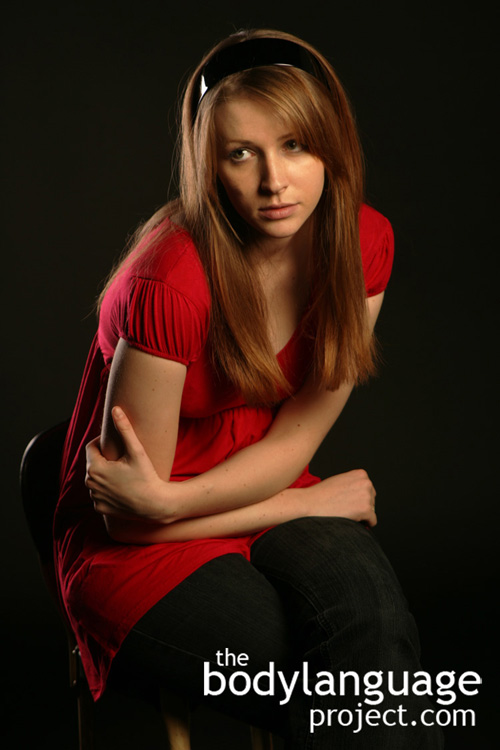Body Language of The Fetal Position
Synonym(s): Hugging The Knees, Pulling The Knees In, Balling Up.
Description: The knees are pulled into the body and hugged.
In One Sentence: Pulling the knees into the body is akin to the fetal position and is a protective posture signaling the need for emotional comfort.
How To Use it: Use this cue to signal that you are under distress and wish for others to offer care and support. Balling the body in this way can produce a smaller profile making the body feel like a smaller, less noticeable target. Hugging the knees also simulates the sensation of being hugged, thus activating the embodiment of being comforted. The sensation is not unlike being hugged by parents. Thus, the fetal position is a way we can self-sooth when parents or friends are not nearby.
Context: General.
Verbal Translation: “I need to feel the comfort of being held to remind me of the protection I felt in my mom’s womb or when she snuggled me, as I am suffering extreme discomfort and stress.”
Variant: See Bow and Body Bend, Crouching, Self-Hugging or The Double Arm Hug.
Cue In Action: a) She was alone for the first time at camp and hugged her knees while the other girls read scary books and fooled around. b) When she found out about a death in the family, she balled herself up on the couch and a grief filled expression came across her face.
Meaning and/or Motivation: It is a child-like posture because it reminds us of being protected by our mothers. It signifies grief, fear, timidity, shyness, discomfort and pain. The body shows that it needs to take on a smaller profile and seek comfort at the same time. As adults, we must provide comfort for ourselves so we are forced to use our own arms and legs to self-hug. With age, we learn that taking up the fetal position, like thumb sucking, is not an acceptable way of dealing with our insecurity so we drop the extreme form of the gesture in favour of more subtle cues.
In mild forms, it can be simply a posture one uses for comfort. When it appears in public it signifies that a person has an underlying motivation for pacifying and feels insecure. When done at home, can simply be a way to feel embraced and cared for.
While it might seem far-fetched to expect someone in your company to have this posture, it does occur although in more abbreviated adult acceptable ways. While at an informal party, for example, a woman might find herself hugging her knees at the end of a couch. To her, this feels comfortable, which is why she does it, but it reveals her true emotions.
The abbreviated form of this position, of course, and one that is more acceptable in public is to pull the limbs in closer to the body and across the centerline as in the “self hug”.
Cue Cluster: The fetal position is commonly associated with averted or wandering eyes, head turned away or down, being quiet, reading a book, wearing headphones or other ways to escape coupled with an expressionless, worry or pensive facial expression.
Body Language Category: Auto contact or self touching, Barriers, Body cross, Body size reduction, Blocking or Shielding, Defensive, Low confidence body language, Negative body language, Nervous body language, Pseudo-infantile gestures, Protective reflexes, Shy nonverbal.
Resources:
Atkinson A, Dittrich W, Gemmell A, Young A. Emotion perception from dynamic and static body expressions in point-light and full-light displays. Perception 2004;33:717–46.
Aviezer H, Trope Y, Todorov A. Body cues, not facial expressions, discriminate between intense positive and negative emotions. Science 2012;338:1225–9.
Adams, E.S., Mesterton-Gibbons, M., 1995. The cost of threat displays and the stability of deceptive communication. J. Theor. Biol. 175, 405–421.
Boyson, A. R., Pryor, B., & Butler, J. (1999). Height as power in women. North American Journal of Psychology, 1, 109–114.
Burgoon, J. K., & Hoobler, G. (2002). Nonverbal signals. In M. L. Knapp & J. A. Daly (Eds.), Handbook of interpersonal communication (3rd ed., pp. 240–299). Thousand Oaks, CA: Sage.
Burgoon, J. K., Johnson, M. L., & Koch, P. T. (1998). The nature and measurement of interpersonal dominance. Communication Monographs, 65, 308–335.
Bartlett Marian S, Littlewort Gwen C, Frank Mark G, Lee K. Automatic decoding of facial movements reveals deceptive pain expressions. Curr Biol 2014;24:738–43.
Boucher J, Carlson G. Recognition of facial expression in three cultures. J Cross Cult Psychol 1980;11:263–80.
Bartholomewn, Morgan E.; Sheri L. Johnson. Nonverbal Dominance Behavior Among Individuals at Risk for Mania. Journal of Affective Disorders. 2014. 159: 133-138.
http://bodylanguageproject.com/articles/failure-to-use-submissive-body-language-linked-to-bipolar-and-mania-study/
Blidstein, Gerald J. The Nonverbal Language of Prayer (review).Shofar: An Interdisciplinary Journal of Jewish Studies. 2007 25(2): 195-196.
Bertamini, Marco ; Byrne, Christopher ; Bennett, Kate M. Attractiveness is influenced by the relationship between postures of the viewer and the viewed person. i-Perception. 2013. 4(3): 170-179.
Cashdan, Elizabeth. Smiles, Speech, and Body Posture: How Women and Men Display Sociometric Status and Power. Journal of Nonverbal Behavior. 1998. 22(4): 209-228.
Cunha, U. ; Leduc, M. ; Nayak, U.S.L. ; Isaacs, B.. Why do old people stoop? Archives of Gerontology and Geriatrics. 1987 6(4): 363-369.
Carney, D. R., Hall, J. A., & LeBeau, L. S. (2005). Beliefs about the nonverbal expression of social power. Journal of Nonverbal Behavior, 29, 105–123.
Coulson M. Attributing emotion to static body postures: recognition accuracy, confusions, and viewpoint dependence. J Nonverbal Behav 2004;28:117–39.
Dunn, Cynthia Dickel. Speaking politely, kindly, and beautifully: ideologies of politeness in Japanese business etiquette training. Multilingua: Journal of Cross-Cultural and Interlanguage Communication. 2013. 32(2): 225(21
Ellis, L. (1994). The high and the mighty among man and beast: How universal is the relationship between height (or body size) and social status? In L. Ellis (Ed.). Social stratification and socioeconomic inequality (Vol. 2, pp. 93–111). Westport, CT: Praeger Publishers.
Ekman P, Friesen W. Head and body cues in judgement of emotion—a reformulation. Percept Mot Skill 1967;24:711–24.
Dijkstra, Katinka; Michael P. Kaschak; and Rolf A. Zwaan. Body Posture Facilitates Retrieval of Autobiographical Memories. Cognition. 2007; 102: 139-149.
http://bodylanguageproject.com/articles/improve-recall-match-posture-memory-study/
Eddie Harmon-Jones and Carly K. Peterson. Supine Body Position Reduces Neural Response to Anger. Association for Psychological Science. 2009; 20 (10): 1209-1210.
http://bodylanguageproject.com/articles/supine-body-posture-reduces-aggression/
Flack, William F., Jr. Peripheral Feedback Effects of Facial Expressions, Bodily Postures, and Vocal Expressions on Emotional Feelings. Cognition and Emotion. 2006. 20 (2), 177-195. DOI:10.1080/02699930500359617
http://bodylanguageproject.com/articles/body-and-facial-expressions-influence-mood/
Glenn E. Weisfeld and Jody M. Beresford. 1982. Erectness of posture as an indicator of dominance or success in humans. Motivation and Emotion. 6(2):113 -131.
Ginsburg, Harvey J. ; Pollman, Vicki A. ; Wauson, Mitzi S. Odom, Richard D. (editor). An ethological analysis of nonverbal inhibitors of aggressive behavior in male elementary school children. Developmental Psychology. 1977 13(4): 417-418.
Girard, Jeffrey M.; Jeffrey F. Cohna; Mohammad H.Mahoor S.; Mohammad Mavadati;
Zakia Hammal; and Dean P. Rosenwalda. Nonverbal Social Withdrawal In Depression: Evidence From Manual And Automatic Analyses. Image and Vision Computing. 2013.
http://bodylanguageproject.com/articles/body-language-signals-withdrawal-depression
Geisser M, Robinson M, Keefe F, Weiner M. Catastrophizing, depression and the sensory, affective and evaluative aspects of chronic pain. PAIN. 1994;59:79–83.
Hall, Judith ; LeBeau, Lavonia ; Reinoso, Jeannette ; Thayer, Frank. Status, Gender, and Nonverbal Behavior in Candid and Posed Photographs: A Study of Conversations Between University Employees. Sex Roles. 2001 44(11): 677-692.
Keogh E. Gender differences in the nonverbal communication of pain: A new direction for sex, gender, and pain research? PAIN_ 2014;155:1927–31.
Kret M, Pichon S, Grezes J, de Gelder B. Similarities and differences in perceiving threat from dynamic faces and bodies. An fMRI study. NeuroImage 2011;54:1755–62.
Katza, Carmit; Irit Hershkowitz; Lindsay C. Malloya; Michael E. Lamba; Armita Atabakia and Sabine Spindlera. Non-Verbal Behavior of Children Who Disclose or do not Disclose Child Abuse in Investigative Interviews. Child Abuse & Neglect. 2012. 36: 12-20.
http://bodylanguageproject.com/articles/reading-nonverbal-behaviour-child-abuse-cases-encourage-children-divulge-information-truth-telling
LaFrance, Marianne. 1982. Posture mirroring and rapport. In M. Davis (Ed.) Interaction rhythms: periodicity in communicative behavior (279-298). New York, Human Sciences Press, Inc.
LaFrance, Marianne. and W. Ickes. 1981. Posture mirroring and interactional involvement: sex and sex typing effects. Journal of Nonverbal Behavior 5: 139-154.
Mondloch, Catherine J. Sad or Fearful? The Influence of Body Posture on Adults’ and Children’s Perception of Facial Displays of Emotion. Journal of Experimental Child Psychology. 2012. 111(2): 180-196.
Michalak, Johannes, Judith Mischnat and Tobias Teismann. Sitting Posture Makes a Difference—Embodiment Effects on Depressive Memory Bias. Clinical Psychology and Psychotherapy. 2014. 21, 519-524. DOI: 10.1002/cpp.1890
http://bodylanguageproject.com/articles/sit-can-embody-depression-body-language-postures-control-mental-processes/
Michalak, J., Troje, N. F., Fischer, J., Vollmar, P., Heidenreich, T., and Schulte, D. Embodiment of sadness and depression— Gait patterns associated with dysphoric mood. Psychosomatic Medicine. 2009. 71, 580–587.
Malatynska, E.,Knapp,R.J.,2005.Dominant-Submissive Behavior as Models of Mania and Depression. NeuroScience and.Biobehavior .Rev.29(4–5): 715–737, http://dx.doi.org/10.1016/j.neubiorev.2005.03.014.
McGrath P, Johnson G, Goodman J, Schillinger J, Dunn J, Chapman J. CHEOPS—a
behavioral-scale for rating postoperative pain in children. Adv Pain Res Ther 1985;9:395–402.
Meier, B. P., Hauser, D. J., Robinson, M. D., Friesen, C. K., & Schjeldahl, K. (2007b). What’s ‘up’ with God?: Vertical space as a representation of the divine. Journal of Personality and Social Psychology, 93, 699–710.
Meier, B. P., & Robinson, M. D. (2004). Why the sunny side is up: Associations between affect and vertical position. Psychological Science, 15, 243–247.
Meier, B. P., & Robinson, M. D. (2005). The metaphorical representation of affect. Metaphor and Symbol, 21, 239–257.
Meier, B.P., Robinson, M.D., & Caven, A.J. (in press). Why a big mac is a good mac: Associations between affect and size. Basic and Applied Social Psychology.
Melamed, T. (1992). Personality correlates of physical height. Personality and Individual Differences, 13, 1349–1350.
Middleton, W. C., &Moffett, D. C. (1940). The relation of height and weight measurements to intelligence and to dominance-submission among a group of college freshmen. Research Quarterly of the American Association for Health, Physical Education, and Recreation, 11, 53–59.
Montepare, J. M. (1995). The impact of variations in height on young children’s impressions of men and women. Journal of Nonverbal Behavior, 19, 31–47.
Mehrabian, Albert Holzberg, Jules D. (editor). Inference of Attitudes From the Posture, Orientation and Distance of a Communicator. Journal of Consulting and Clinical Psychology. 1968. 32(3): 296-308.
Mehrabian, Albert Deese, James (editor). Significance of posture and position in the communication of attitude and status relationships. Psychological Bulletin. 1969. 71(5): 359-372.
Matsumoto, D., & Willingham, B. (2006). The thrill of victory and the agony of defeat: Spontaneous expressions of medal winners of the 2004 Athens Olympic Games. Journal of Personality and Social Psychology, 91(3), 568–581.
Mouterde, S. C., Duganzich, D. M., Molles, L. E., Helps, S., Helps, R., & Waas, J. R. (2012). Triumph displays inform eavesdropping little blue penguins of new dominance asymmetries. Animal Behaviour, 83, 605–611.
Matsumura, Shuichi ; Hayden, Thomas J. When should signals of submission be given?–A game theory model. Journal of Theoretical Biology. 2006. 240(3): 425-433.
Oosterwijk, S., Rotteveel, M., Fischer, A. H., & Hess, U. Embodied emotion concepts: How generating words about pride and disappointment influences posture. European Journal of Social Psychology. 2009. 39, 457–466.
Oosterwijk, Suzanne; Mark Rotteveel; Agneta H. Fischer and Ursula Hess. Embodied Emotion Concepts: How Generating Words About Pride and Disappointment Influences Posture. European Journal of Social Psychology. 2009. 39: 457–466. DOI: 10.1002/ejsp.584
http://bodylanguageproject.com/articles/embodiment-nonverbal-posture-thinking-pride-shame-literally-changes-body-language/
Prieto, A. G., & Robbins, M. C. (1975). Perceptions of height and self-esteem. Perceptual and Motor Skills, 40, 395–398.
Pitterman, Hallee ; Nowicki Jr, Stephen. A Test of the Ability to Identify Emotion in Human Standing and Sitting Postures: The Diagnostic Analysis of Nonverbal Accuracy-2 Posture Test (DANVA2-POS). Genetic, Social, and General Psychology Monographs. 2004. 130(2): 146-162.
Pablo Briñol; Richard E. Petty and Benjamin Wagner. Body Posture Effects on Self-Evaluation: A Self-Validation Approach. European Journal of Social Psychology. 2009. 39(6): 1099-0992. DOI: 10.1002/ejsp.607. http://dx.doi.org/10.1002/ejsp.607
http://bodylanguageproject.com/articles/fix-posture-fix-confidence/
Pablo Brin and Oli Richard. Body posture effects on self-evaluation: A self-validation approach. European Journal of Social Psychology. 2009; 39: 1053–1064.
http://bodylanguageproject.com/articles/posture-affects-confidence-of-thoughts/
Park, Lora E.; Lindsey Streamer; Li Huang and Adam D. Galinsky. Stand Tall, But Don’t Put Your Feet Up: Universal and Culturally-Specific Effects of Expansive Postures On Power. Journal of Experimental Social Psychology. 2013; 49: 965–971.
http://bodylanguageproject.com/articles/are-expansive-postures-of-power-universal-or-cultural/
Riskind, J. H. Nonverbal Expressions and the Accessibility of Life Experience Memories: A Congruence Hypothesis. Social Cognition. 1983. 2: 62-86.
Rand, G., and Wapner, S. Postural Status as a Factor in Memory. Journal of Verbal Learning and Verbal Behavior. 1967. 6: 268-271.
Rule, Nicholas, O.; Reginald B. Adams Jr.; Nalini Ambady and Jonathan B. Freeman. Perceptions Of Dominance Following Glimpses Of Faces And Bodies. Perception. 2012; 41: 687-706 doi:10.1068/p7023
http://bodylanguageproject.com/articles/people-can-read-dominance-split-second
Robinson, Michael D. ; Zabelina, Darya L. ; Ode, Scott ; Moeller, Sara K. The vertical nature of dominance-submission: Individual differences in vertical attention. Journal of Research in Personality. 2008. 42(4): 933-948.
Simon D, Craig K, Gosselin F, Belin P, Rainville P. Recognition and discrimination of prototypical dynamic expressions of pain and emotions. PAIN_ 2008;135:55–64.
Schubert, T. W. (2005). Your highness: Vertical positions as perceptual symbols of power. Journal of Personality and Social Psychology, 89, 1–21.
Schwartz, B., Tesser, A., & Powell, E. (1982). Dominance cues in nonverbal behavior. Social Psychology Quarterly, 45, 114–120.
Stepper, S., & Strack, F. (1993). Proprioceptive determinants of emotional and nonemotional feelings. Journal of Personality and Social Psychology, 64, 211–220.
Schenkel, Rudolf. Submission: Its Features and Function in the Wolf and Dog. American Zoologist. 1967. 7(2): 319-329.
Tomei, Alexander and Jeremy Grivel. Body Posture and the Feeling of Social Closeness: An Exploratory Study in a Naturalistic Setting. Current Psychology. 2014. 33:35–46
DOI 10.1007/s12144-013-9194-1
http://bodylanguageproject.com/articles/stand-increase-feelings-closeness-use-body-posture-influence-perception/
Tiedens, Larissa Z ; Fragale, Alison R. Power moves: complementarity in dominant and submissive nonverbal behavior. Journal of personality and social psychology. 2003. 84(3): 558-68.
Tracy, J. L., & Matsumoto, D. (2008). The spontaneous expression of pride and shame: Evidence for biologically innate nonverbal displays. Proceedings from the National Academy of Sciences, 105(33), 11655–11660.
Tracy, J. L., & Robins, R. W. (2007). The prototypical pride expression: Development of a nonverbal behavior coding system. Emotion, 7(4), 789–801.
Tracy, J. L., & Robins, R. W. (2004). Show your pride: Evidence for a discrete emotion expression. Psychological Science, 15, 194–197.
Weisfeld, Glenn E. and Jody M. Beresford. Erectness of Posture as an Indicator of Dominance or Success in Humans. Motivation and Emotion. 1982. 6(2): 113-130.
http://bodylanguageproject.com/articles/body-language-cues-dominance-submission-children/
Walsh, Joseph ; Eccleston, Christopher ; Keogh, Edmund. Pain communication through body posture: The development and validation of a stimulus set. Pain. 2014. 155(11): pp.2282-2290
Welker, Keith M. ; Oberleitner, David E. ; Cain, Samantha ; Carré, Justin M. Upright and left out: Posture moderates the effects of social exclusion on mood and threats to basic needs. European Journal of Social Psychology. 2013 43(5): 355-361







